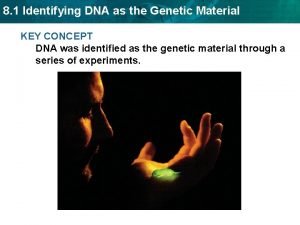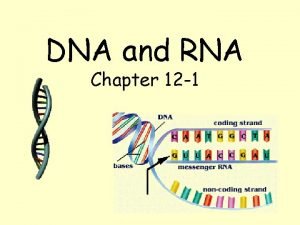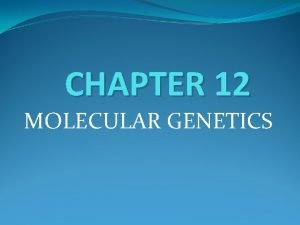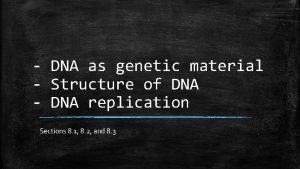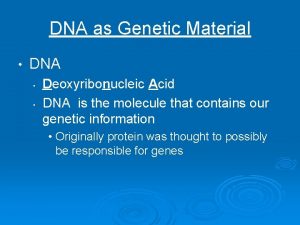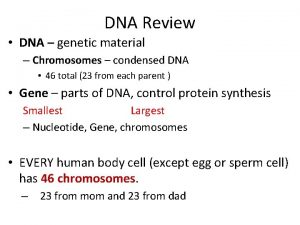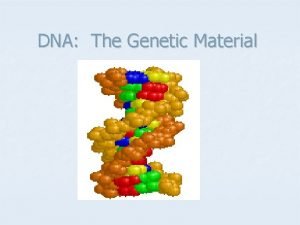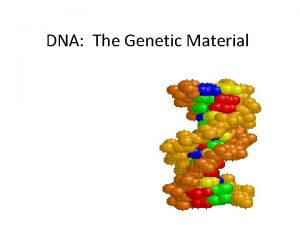DNA AS A GENETIC MATERIAL Experiments for genetic










- Slides: 10

DNA AS A GENETIC MATERIAL Experiments for genetic material---nucleic acid or protein/DNA or RNA? • • • Griffith’s Transformation Experiment Avery’s Transformation Experiment Hershey-Chase Bacteriophage Experiment

Search for the genetic material: 1. Stable source of information 2. Ability to replicate accurately 3. Capable of change Timeline of events: • 1890 Weismann - substance in the cell nuclei controls development. • 1900 Chromosomes shown to contain hereditary information, later shown to be composed of protein & nucleic acids. • 1928 Griffith’s Transformation Experiment • 1944 Avery’s Transformation Experiment • 1953 Hershey-Chase Bacteriophage Experiment • 1953 Watson & Crick propose double-helix model of DNA

• Fred Griffith (1928) – Experiments with pneumonia and bacterial transformation determined that there is a molecule that controls inheritance. • Oswald T. Avery (1944) - Transformation experiment determined that DNA was the genetic material responsible for Griffith’s results (not RNA). • Hershey-Chase Experiments (1952) – discovered that DNA from viruses can program bacteria to make new viruses.

Frederick Griffith’s Transformation Experiment • The discovery of the genetic role of DNA began with research by Frederick Griffith in 1928 • Griffith worked with two strains of a bacterium, a pathogenic “S” strain and a harmless “R” strain • When he mixed heat-killed remains of the pathogenic strain with living cells of the harmless strain, some living cells became pathogenic • He called this phenomenon transformation, now defined as a change in genotype and phenotype due to assimilation of foreign DNA

Frederick Griffith’s Transformation Experiment - 1928 “transforming principle” demonstrated with Streptococcus pneumoniae Griffith hypothesized that the transforming agent was a “IIIS” protein.

Oswald T. Avery’s Transformation Experiment • In 1944, Oswald Avery, Maclyn Mc. Carty, and Colin Mac. Leod announced that the transforming substance was DNA • Their conclusion was based on experimental evidence that only DNA worked in transforming harmless bacteria into pathogenic bacteria • Many biologists remained skeptical, mainly because little was known about DNA

Oswald T. Avery’s Transformation Experiment - 1944 Determined that “IIIS” DNA was the genetic material responsible for Griffith’s results (not RNA). Peter J. Russell, i. Genetics: Copyright © Pearson Education, Inc. , publishing as Benjamin Cummings.

Hershey-Chase Bacteriophage Experiment - 1953 Bacteriophage = Virus that attacks bacteria and replicates by invading a living cell and using the cell’s molecular machinery. Structure of T 2 phage DNA & protein

Life cycle of virulent T 2 phage:

Hershey-Chase Bacteriophage Experiment - 1953 1. T 2 bacteriophage is composed of DNA and proteins: 2. Set-up two replicates: • • Label DNA with 32 P Label Protein with 35 S 3. Infected E. coli bacteria with two types of labeled T 2 4. 32 P is discovered within the bacteria and progeny phages, whereas 35 S is not found within the bacteria but released with phage ghosts. 1969: Alfred Hershey
 Chapter 12 section 1 molecular genetics answer key
Chapter 12 section 1 molecular genetics answer key Section 1 identifying dna as the genetic material
Section 1 identifying dna as the genetic material Chapter 12 molecular genetics
Chapter 12 molecular genetics Chapter 12 dna and rna section 12-1
Chapter 12 dna and rna section 12-1 Molecular genetics section 1 dna the genetic material
Molecular genetics section 1 dna the genetic material Section 12-1 dna
Section 12-1 dna Genetic programming vs genetic algorithm
Genetic programming vs genetic algorithm What is the difference between genetic drift and gene flow
What is the difference between genetic drift and gene flow Genetic drift vs gene flow
Genetic drift vs gene flow Genetic drift vs genetic flow
Genetic drift vs genetic flow Genetic programming vs genetic algorithm
Genetic programming vs genetic algorithm

